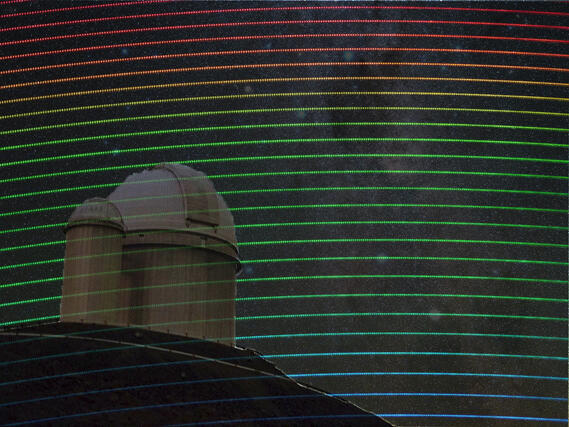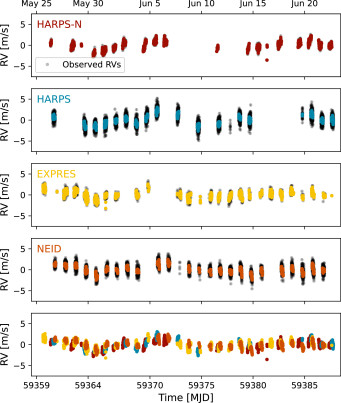Menlo Systems' product:

AstroComb
The Most Precise Calibration System for Astronomical Spectrographs
Four Eyes Probe the Skies
In order to determine whether light emanating from the surface of a star reaches us in an unperturbed form or is affected by interactions with orbiting planets, researchers led by Lily L. Zhao, who is based at the Center for Computational Astrophysics in the Flatiron Institute in New York City, has compared spectrographic data obtained by four different instruments. Menlo Systems’ AstroComb optical frequency comb played a vital role in the spectrograph calibration.
The surface of the Sun is never at rest. The outermost layer of our star – otherwise known as the photosphere – forms the interface from which the Sun’s energy escapes into space. With a temperature of 5500°C, this boundary layer is in ceaseless churning motion, and often launches colossal plumes or “protuberances” into space. Sunspot activity develops in a cyclic fashion and it too can have a considerable impact on the high-energy particles that are emitted from the surface, as well as having effects on our home planet. For centuries, these phenomena have been observed with the aid of instruments on Earth, and technical innovations continue to enhance the sensitivity with which they can be detected and quantified.
Indeed, in the search for exoplanets (planets in solar systems far from our own) that resemble the Earth in terms of size, composition and distance from their central star, highly sensitive instrumentation is indispensable. Only in this way can minimal shifts in the spectrum of the radiation emitted by the local star be detected. In this context, astronomers often need to know whether or not shifts in the spectra obtained are the outcome of activities on the surface of the star itself or reflect interactions with planetary bodies in the system concerned.

(Figure taken from original publication)
In an effort to improve the reliability with which such solar and planetary phenomena can be characterized, a team led by Lily L. Zhao at the Center for Computational Astrophysics in the Flatiron Institute in New York City, and Jason T. Wright at the Department of Astronomy & Astrophysics, Pennsylvania State University, have compared spectral data from the Sun acquired by four different high-resolution and stabilized spectrographic systems located at different observatories around the globe: HARPS, EXPRES, NEID und HARPS-N. The researchers hoped to learn how best to distinguish features that originate on the surface of the Sun from signals that can be reliably attributed to planets in our solar system.
The phenomenon known as the Doppler effect or Doppler shift makes an important contribution to spectrographic measurements. The term refers to the apparent change in the observed frequency of propagating sound or light waves caused by a relative motion between the source and the observer: as the two approach one another, the frequency increases; conversely, if they are moving away from one another, the frequency decreases. In astronomy, the Doppler shift of a well-known frequency is a measure of the radial velocity of the star emitting this particular light frequency.
In the context of signals emanating from the surface of a star, the Doppler phenomenon applies to the variations in the wavelength of light that occur when the distance between the emitter (the star) and the receptor (in this case, the spectrograph on Earth) changes during transmission of the light signal. Since most stars rotate, the spectrum of their approaching side is shifted to a shorter wavelength (which gives rise to a ‘blue shift’), while the receding side undergoes a ‘red shift’ to a longer wavelength. When dark spots on the star’s surface appear on the approaching side as the star rotates, the level of blue light detected at the spectrometer will initially decrease, so that the star appears to be moving away. When such sunspots move out over the receding side, the amount of red light will decrease, causing an apparent radial velocity of the star towards the detector.
In the case of our own star, the team of astrophysicists measured the magnitude of the Doppler shift as accurately as possible with the aid of four different spectrographs. “Based on our solar observations, we are now able to fully characterize the level of the expected Doppler effect”, says Andrew Szymkowiak, one of the authors of the new publication. His own interests are, however, focused less on the Sun‘s activity than on the quest for small, rocky planets orbiting distant stars. “Thanks to our simultaneous observations of the Sun with the aid of four different instruments, we are now in a position to gain new insights into the precision and accuracy of the radial velocities of stars,” Szymkowiak explains. “My own team‘s interests in solar activity are focused solely on defining the degree to which errors in the measurement of radial velocities act as a source of noise in our measurements of planetary dynamics”.
Therefore, the actual sources of measured radial velocity variations remain to be determined. In the search for exoplanets, the radial velocity approach seeks to measure the wiggling motion of the star’s center-of-mass caused by the planet and the star orbiting around their common center of mass. This wiggling gives rise to a periodic Doppler shift in the spectrum of the star. Precisely stabilized spectrographs are capable of measuring radial velocities with an accuracy of less than a meter per second.
The frequency calibration of the spectrographs HARPS, EXPRES, and NEID, was performed by Menlo Systems’ AstroComb, while in the case of the HARPS-N instrument, a Fabry-Perot white light interferometer was used. The AstroComb is based on the Nobel Prize-winning frequency-comb technology (Theodor Hänsch, 2005). This precise frequency measurement is based on the following principle. Each spectrograph splits the incoming light into its spectral components, yielding characteristic features such as absorption lines. These appear in a spectrum when light at a specific frequency is absorbed by chemical elements present on the surface of the star. In order to quantify minute variations of these absorption frequencies, optical frequency combs serve as a reference. These emit a broad spectrum of equidistant and narrow frequency lines. In this way, the absorption frequencies in the light from the star can be determined with an accuracy of one part in 1015 over a broad spectral range.
Spectrograph calibration with the aid of an AstroComb is stable and highly reproducible, and hence minimizes systematic errors. These features are particularly important for long-term observations, and for comparisons between data obtained at different times or from different instruments. For example, the detection of some small exoplanets, which orbit at a large distance from their Sun-seized central star, requires an accuracy of few cm/s over a period of several years, while direct observations of an increasing cosmic expansion rate require an accuracy of 1 cm/s over decades. Moreover, the high level of automation makes calibration with AstroCombs efficient, which is particularly advantageous in the context of large-scale astronomical studies.
“Our direct comparisons between the radial velocities measured by the individual instruments demonstrate a remarkable level of concordance, with a residual scatter of only 15-30 cm/s over the course of a day. That level of performance confirms that the latest ultrastable instruments have attained a degree of precision that is capable of faithfully capturing the full range of stellar variability”, says Lily Zhao, first author of the study. Indeed, the combination of solar data obtained by different spectrographs has turned out to be a highly efficient means of characterizing light from the outer reaches of the Universe. Zhao is therefore convinced that “this capability will make it possible for us to detect further Earth-like exoplanets with a greater degree of confidence”.
Author: Thorsten Naeser
Original publication:
Lily L. Zhao et al.:
The Extreme Stellar-signals Project. III. Combining Solar Data from HARPS, HARPS-N, EXPRES, and NEID;
The Astronomical Journal, 166:173 (17pp), 2023
DOI: 10.3847/1538-3881/acf83e